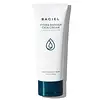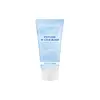What's inside
What's inside
 Key Ingredients
Key Ingredients

 Benefits
Benefits

 Concerns
Concerns

 Ingredients Side-by-side
Ingredients Side-by-side

Centella Asiatica Extract
CleansingButylene Glycol
Humectant1,2-Hexanediol
Skin ConditioningNiacinamide
SmoothingCetearyl Olivate
Cetearyl Alcohol
EmollientCaprylic/Capric Triglyceride
MaskingCetyl Ethylhexanoate
EmollientSorbitan Olivate
EmulsifyingCoco-Caprylate/Caprate
EmollientPrunus Amygdalus Dulcis Oil
Skin ConditioningCeramide NP
Skin ConditioningCeramide Ns
Skin ConditioningSodium Hyaluronate
HumectantCeramide AP
Skin ConditioningCeramide As
Skin ConditioningHydroxypropyltrimonium Hyaluronate
Hydrolyzed Hyaluronic Acid
HumectantSodium Acetylated Hyaluronate
HumectantHyaluronic Acid
HumectantCeramide EOP
Skin ConditioningPotassium Hyaluronate
Skin ConditioningHydrolyzed Sodium Hyaluronate
Skin ConditioningSodium Hyaluronate Crosspolymer
HumectantPhytosphingosine
Skin ConditioningAcetyl Hexapeptide-8
HumectantGlyceryl Caprylate
EmollientArginine
MaskingAllantoin
Skin ConditioningCaprylyl Glycol
EmollientEthylhexylglycerin
Skin ConditioningDipotassium Glycyrrhizate
HumectantHydrogenated Lecithin
EmulsifyingAdenosine
Skin ConditioningSodium Acrylates Copolymer
Glyceryl Stearate Se
EmulsifyingGlyceryl Stearate
EmollientCarbomer
Emulsion StabilisingLecithin
EmollientStearic Acid
CleansingPanthenol
Skin ConditioningCholesterol
EmollientWater
Skin ConditioningCentella Asiatica Extract, Butylene Glycol, 1,2-Hexanediol, Niacinamide, Cetearyl Olivate, Cetearyl Alcohol, Caprylic/Capric Triglyceride, Cetyl Ethylhexanoate, Sorbitan Olivate, Coco-Caprylate/Caprate, Prunus Amygdalus Dulcis Oil, Ceramide NP, Ceramide Ns, Sodium Hyaluronate, Ceramide AP, Ceramide As, Hydroxypropyltrimonium Hyaluronate, Hydrolyzed Hyaluronic Acid, Sodium Acetylated Hyaluronate, Hyaluronic Acid, Ceramide EOP, Potassium Hyaluronate, Hydrolyzed Sodium Hyaluronate, Sodium Hyaluronate Crosspolymer, Phytosphingosine, Acetyl Hexapeptide-8, Glyceryl Caprylate, Arginine, Allantoin, Caprylyl Glycol, Ethylhexylglycerin, Dipotassium Glycyrrhizate, Hydrogenated Lecithin, Adenosine, Sodium Acrylates Copolymer, Glyceryl Stearate Se, Glyceryl Stearate, Carbomer, Lecithin, Stearic Acid, Panthenol, Cholesterol, Water
Water
Skin ConditioningButylene Glycol
HumectantCyclopentasiloxane
EmollientGlycerin
HumectantHelianthus Annuus Seed Oil
EmollientSodium Hyaluronate
HumectantPolyglutamic Acid
Skin ConditioningPhenyl Trimethicone
Skin ConditioningSqualane
EmollientOctyldodecanol
EmollientGlycereth-26
HumectantPentylene Glycol
Skin ConditioningHamamelis Virginiana Water
AstringentGlyceryl Stearate Citrate
EmollientPolyglyceryl-3 Distearate
EmulsifyingPolyglyceryl-10 Dilaurate
Dipotassium Glycyrrhizate
HumectantNicotinoyl Dipeptide-23
Skin ConditioningAcetyl Hexapeptide-8
Humectant1,2-Hexanediol
Skin ConditioningCarbomer
Emulsion StabilisingArginine
MaskingAllantoin
Skin ConditioningPanthenol
Skin ConditioningDimethicone Crosspolymer
Emulsion StabilisingSodium Polyacryloyldimethyl Taurate
Emulsion StabilisingCaprylyl Glycol
EmollientDicaprylyl Ether
EmollientAdenosine
Skin ConditioningPropanediol
SolventCaprylhydroxamic Acid
Water, Butylene Glycol, Cyclopentasiloxane, Glycerin, Helianthus Annuus Seed Oil, Sodium Hyaluronate, Polyglutamic Acid, Phenyl Trimethicone, Squalane, Octyldodecanol, Glycereth-26, Pentylene Glycol, Hamamelis Virginiana Water, Glyceryl Stearate Citrate, Polyglyceryl-3 Distearate, Polyglyceryl-10 Dilaurate, Dipotassium Glycyrrhizate, Nicotinoyl Dipeptide-23, Acetyl Hexapeptide-8, 1,2-Hexanediol, Carbomer, Arginine, Allantoin, Panthenol, Dimethicone Crosspolymer, Sodium Polyacryloyldimethyl Taurate, Caprylyl Glycol, Dicaprylyl Ether, Adenosine, Propanediol, Caprylhydroxamic Acid
Ingredients Explained
These ingredients are found in both products.
Ingredients higher up in an ingredient list are typically present in a larger amount.
1,2-Hexanediol is a synthetic liquid and another multi-functional powerhouse.
It is a:
- Humectant, drawing moisture into the skin
- Emollient, helping to soften skin
- Solvent, dispersing and stabilizing formulas
- Preservative booster, enhancing the antimicrobial activity of other preservatives
Acetyl Hexapeptide-8, commonly known as Argireline or Acetyl Hexapeptide-3, is a popular peptide in skincare. It’s often referred to as a “Botox-like” ingredient because it helps reduce muscle movement.
By relaxing these micro-movements, Argireline may help minimize the appearance of fine lines and wrinkles. That said, it’s not as powerful as Botox, and research on its long-term effectiveness is still limited.
Beyond smoothing, Argireline may also support collagen production. Collagen is the protein that helps keep your skin firm, bouncy, and well-hydrated by strengthening the skin barrier.
So while Argireline isn’t a miracle fix, it can be a helpful addition to a routine focused on both prevention and skin health.
Read more about other common types of peptides here:
Learn more about Acetyl Hexapeptide-8Adenosine is in every living organism. It is one of four components in nucleic acids that helps store our DNA.
Adenosine has many benefits when used. These benefits include hydrating the skin, smoothing skin, and reducing wrinkles. Once applied, adenosine increases collagen production. It also helps with improving firmness and tissue repair.
Studies have found adenosine may also help with wound healing.
In skincare products, Adenosine is usually derived from yeast.
Learn more about AdenosineAllantoin is a soothing ingredient known for its protective and moisturizingg properties. Because of this, it is often added to products with strong active ingredients.
Studies show higher concentrations of this ingredient can promote wound healing.
Though it can be derived from the comfrey plant, allantoin is produced synthetically for cosmetic products to ensure purity.
Learn more about AllantoinArginine is an amino acid that is important for human development. Your body uses is it to produce hair keratin and skin collagen.
As a cosmetic ingredient, Arginine has antioxidant properties and can also help repair damaged skin. This ingredient is derived either synthetically or from animals.
Arginine isn't fungal acne safe when used in the presence of other lipids (fats, fatty acids, oils, esters, etc). Oils and fats occur naturally within the skin, so take caution when using Arginine if you're prone to fungal acne.
Learn more about ArginineButylene Glycol (or BG) is used within cosmetic products for a few different reasons:
Overall, Butylene Glycol is a safe and well-rounded ingredient that works well with other ingredients.
Though this ingredient works well with most skin types, some people with sensitive skin may experience a reaction such as allergic rashes, closed comedones, or itchiness.
Learn more about Butylene GlycolCaprylyl Glycol is a humectant and emollient, meaning it attracts and preserves moisture.
It is a common ingredient in many products, especially those designed to hydrate skin. The primary benefits are retaining moisture, skin softening, and promoting a healthy skin barrier.
Though Caprylyl Glycol is an alcohol derived from fatty acids, it is not the kind that can dry out skin.
This ingredient is also used as a preservative to extend the life of products. It has slight antimicrobial properties.
Learn more about Caprylyl GlycolCarbomer is a polymer of acrylic acid. Its main role is to create a gel consistency.
A high amount of carbomer can cause pilling or balling up of products. Don't worry, most products contain 1% or less of carbomer.
Dipotassium Glycyrrhizate comes from licorice root.
Extracts of licorice have demonstrated to have antibacterial, anti‐inflammatory, antiviral, antioxidant properties.
One component, glabridin, has extra potent antioxidant and soothing properties. It has also been found to block pigmentation from UVB rays in guinea pigs.
Licorice Root also contains a flavonoid. Flavonoids are a natural substance from in plants. Flavonoids also have antioxidant properties.
Another component, glycyrrhizin, has been found to have anti-inflammatory and antimicrobial benefits. This may make licorice root extract effective at treating acne. However, more research is needed to support this.
Liquiritin is one of the flavone compounds found in licorice. It has been found to help lighten skin by preventing tyrosinase from reacting with tyrosine. When the two react, protein is converted to melanin. Melanin is the substance in your body that gives your features pigmentation.
Licorice root is native to Southern Europe and Asia. It has been used in traditional Chinese medicine to help with respiratory issues.
Learn more about Dipotassium GlycyrrhizatePanthenol is a common ingredient that helps hydrate and soothe the skin. It is found naturally in our skin and hair.
There are two forms of panthenol: D and L.
D-panthenol is also known as dexpanthenol. Most cosmetics use dexpanthenol or a mixture of D and L-panthenol.
Panthenol is famous due to its ability to go deeper into the skin's layers. Using this ingredient has numerous pros (and no cons):
Like hyaluronic acid, panthenol is a humectant. Humectants are able to bind and hold large amounts of water to keep skin hydrated.
This ingredient works well for wound healing. It works by increasing tissue in the wound and helps close open wounds.
Once oxidized, panthenol converts to pantothenic acid. Panthothenic acid is found in all living cells.
This ingredient is also referred to as pro-vitamin B5.
Learn more about PanthenolSodium Hyaluronate is hyaluronic acid's salt form. It is commonly derived from the sodium salt of hyaluronic acid.
Like hyaluronic acid, it is great at holding water and acts as a humectant. This makes it a great skin hydrating ingredient.
Sodium Hyaluronate is naturally occurring in our bodies and is mostly found in eye fluid and joints.
These are some other common types of Hyaluronic Acid:
Learn more about Sodium HyaluronateWater. It's the most common cosmetic ingredient of all. You'll usually see it at the top of ingredient lists, meaning that it makes up the largest part of the product.
So why is it so popular? Water most often acts as a solvent - this means that it helps dissolve other ingredients into the formulation.
You'll also recognize water as that liquid we all need to stay alive. If you see this, drink a glass of water. Stay hydrated!
Learn more about Water